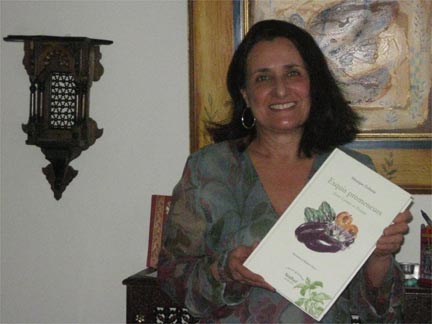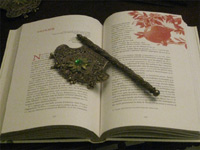What sex is a coffee bean, where does the aubergine come from?
by Rosslyn Hyams
Article published on the 2010-01-08 Latest update 2010-01-15 09:51 TU
There's surprise on a Paris market when traders hear where the fruit and vegetables they sell originally came from. A new book could tell them the history of most of the produce that passes through their hands.
Culture in France: Exquisite wanderers
On a market in a frosty Place des Fêtes, fruit and veg sellers cheerily weigh turnips and hew chunks of bright orange pumpkin or tumble clementines into plastic bags and chat with the customers.
Laid out carefully on the stalls are bright red bell peppers, sharp green lettuces, and aubergines, amongst other fruits and vegetables.
But how often do we do more than just look at them, wonder if the price has gone up, or consider how we are going to eat them?
Have you ever wondered just how far they and their ancestors have travelled to reach that market stall in Paris?
Augustin, a young man working on the market, says the aubergines on his stall come from Spain. Originally perhaps, he says with a shrug of the shoulders, from Provence in the south of France.He's surprised to hear that they could have arrived in the Mediterranean region centuries ago after travelling from as far away as India via Persia, Baghdad, Egypt and Syria.
I was amazed, too, to find out about the history of the aubergine, and fascinated to read about its travels in time and space - and that of about 20 other fruits, vegetables, spices and grains - in Exquis Promeneurs (Exquisite Wanderers) a new book by Monique Zetlaoui, prettily illustrated by Stephanie Buttier.
Zetlaoui, orginally from the Mediterranean, but more recently a resident of Paris, says that her love of history and of these foods that she has always known, led her to write their stories and to travel with them.
“I think we feel the same way with fruit as people have done since time immemorial," she says. "When we pick a fruit today, the pleasure is the same. We smell the fruit, we savour it. Lots of fruits and vegetables are round, and it was like travelling around the world to find out everything about a peach or a quince or a peach.”
With each entry, there are several recipes, some of them famous throughout the Mediterranean today, like tagine or stuffed peppers, others from the distant past.
Although, less entertaining and ostensibly more practical to read perhaps than the travels of an aubergine, this is where we get to the heart of the book.
“They’re not just recipes," says Zetlaoui. "They are my children’s favourites. And they are passed down from generation to generation and even if things get changed, for example, my daughter doesn’t like to use as much cumin as I do, I don’t want to break the chain, I want to transmit this.”
In Exquis Promeneurs, each story of each fruit or vegetable is like an ode to it, or a homage. Each one is written in such a way, as the reader is drawn into the intimate relationship Zetlaoui shares with the artichoke or saffron, not to mention the coffee bean or the pimento!
“A coffee bean is clearly masculine," she feels. "It’s what you wait for so impatiently in bed when you wake up in the morning ... A pimento is like that burning first kiss you swear you will never give again, and yet, you cannot resist it - you do and you fall in love.”
So why not rethink our own attitudes to contemplation of some of the fruit or vegetables or spices we all use in our daily lives, even if they are not the same ones which are now known as Mediterranean?
Zetlaoui says she took a certain liberty in personifying them. She says that they are masculine or feminine according to her logic. A lettuce she says wears frilly or circular skirts and needs to take care of her wrinkles!
Exquis Promeneurs is more than a history book, more than a story book, more than a food/cookbook. It's teeming with references to Mediterranean or other cultures, such those of India or the Persian Gulf.
Furthermore, it contains the etymology of the names of the fruits and vegetables such as the fig, which we learn in Sumerian was pesh, in Aramaic was tina, in Arabic tin or kermus, te'enna in Hebrew, sukon in Greek and then ficus in Latin.
Culture
Cracking skulls!
2010-02-15 12:35 TU
France's gothic avant-garde
2010-02-13 15:16 TU
Winter sounds warm up French jazz fans
A tribute to trumpeter Don Cherry at a Free Jazz showcase festival outside of Paris.
2010-01-31 11:55 TU
Trance on a trapeze
2010-01-30 12:41 TU
Retro Mobile - classic car exhibition
260,500 euros for rusty old car found at bottom of lake
A rusty old Bugatti, which spent years at the bottom of a Swiss lake, sold for 260,500 euros at the Retro Mobile classic car exhibition on Saturday. Other more lovingly-restored pristine examples are exciting enthusiasts from across the world in a special anniversary event at Porte de Versailles in Paris.
2010-01-23 20:21 TU
France's changing face looks east
2010-01-22 16:17 TU
Putting art on film
2010-01-20 13:09 TU
Cocteau Twin flying solo
2010-01-06 16:43 TU
A taste of Nordic filmmaking in Paris
Ciné Nordica 2009 at Paris’s Panthéon cinema showcases filmmaking from Scandinavia. So what makes Nordic film different from the rest?
2009-12-22 17:15 TU















